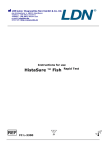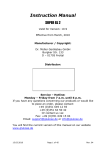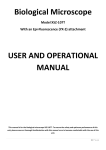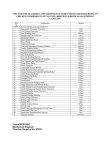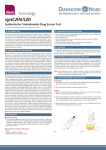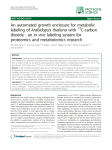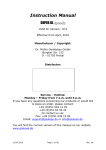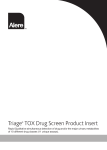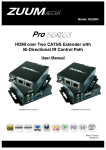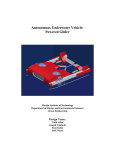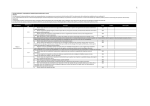Download Histamine Food ELISA
Transcript
Instructions for use Histamine Food ELISA FC E-3100 Histamine Food ELISA 1. Principle of the test Fish meal that has been produced from materials which has been allowed to degrade prior to being processed can contain high levels of histamine and can be toxic. Elevated histamine levels (1,000 ppm) can cause gizzard erosion and black vomit in poultry. Histamine testing in fresh fish is a possible control strategy that can be used by seafood processors in their HACCP program to address the hazard of scombrotoxin formation. Histamine is a product of decomposition of histidine caused by the growth of certain bacteria in seafood. The amount of the amine that forms is a function of bacterial species, the temperature and time of exposure, and may exceed 1,000 ppm (mg/kg). Fish containing high levels of histamine has been associated with many examples of poisoning commonly referred to as “scombroid poisoning,” a major health problem for consumers. Scombrotoxic fish usually contains levels of histamine in excess of 200 ppm but such fish may be randomly dispersed within a lot. For large fish, histamine is found at variable levels even within individual fish. Quality control measures designed to minimize the occurrence of scombrotoxic fish require the determination of histamine levels in the range of approximately 10 to 200 ppm. Good quality fish contain less than 10 ppm histamine, a level of 30 ppm indicates significant deterioration, and 50 ppm is considered to be evidence of definite decomposition. The defect action level (DAL), the level at which regulatory actions are taken for histamine is 50 ppm (P. L. Rogers, W. F. Staruszkiewicz, Journal of Aquatic Food Product Technology, Vol. 9 (2) 2000 p. 5 - 17). The assay kit provides materials for the quantitative determination of derivatized histamine in food extracts. The derivatization is part of the preparation of the samples. By use of the acylation reagent, histamine is quantitatively derivatized into N-acylhistamine. The competitive Histamine ELISA kit uses the microtiter plate format. Histamine is bound to the solid phase of the microtiter plate. Acylated histamine and solid phase bound histamine compete for a fixed number of antiserum binding sites. When the system is in equilibrium, free antigen and free antigen-antiserum complexes are removed by washing. The antibody bound to the solid phase histamine is detected by anti-goat/peroxidase. The substrate TMB/peroxidase reaction is monitored at 450 nm. The amount of antibody bound to the solid phase histamine is inversely proportional to the histamine concentration of the sample. 2. Advice on handling the test 2.1 Reliability of the test results In order to assure a reliable evaluation of the test results it must be conducted according to the instructions included and in accordance with current rules and guidelines (e.g. GLP, RILIBÄK, etc.). Special attention must be paid to control checks for precision and correctness during the test; the results of these control checks have to be within the norm range. In case of significant discrepancies between the pre-set assay characteristics of this test and the actual results please contact the manufacturer of the test kit for further instructions. Complaints In case of complaints please submit to the manufacturer a written report containing all data as to how the test was conducted, the results received and a copy of the original test printout. Please contact the manufacturer to obtain a complaint form and return it completely filled in to the manufacturer. Warranty This test kit was produced according to the latest developments in technology and subjected to stringent internal and external quality control checks. Any alteration of the test kit or the test procedure as well as the usage of reagents from different charges may have a negative influence on the test results and are therefore not covered by warranty. The manufacturer is not liable for damages incurred in transit. Disposal Residual substances and/or all remaining chemicals, reagents and ready for use solutions, are special refuse. The disposal is subject to the laws and regulations of the federation and the countries. About the removal of special refuse the responsible authorities or refuse disposal enterprises inform. The disposal of the kit must be made according to the national official regulations. Legal basis for the disposal of special refuse is the cycle economic- and waste law. The appropriate safety data sheets of the individual products are available on the homepage. The safety data sheets correspond to the standard: ISO 11014-1. Interference Do not mix reagents and solutions from different lots. Consider different transport and storage conditions. Inappropriate handling of test samples or deviations from the test protocol can affect the results . Use no kit components beyond the expiration date. Avoid microbiological contamination of the reagents and the washing water. Consider incubation periods and wash references. 2.2 2.3 2.4 2.5 2.6 Precautions Never pipette by mouth and avoid contact of reagents and specimens with skin. No smoking, eating or drinking in areas where samples or kit test tubes are handled. When working with kit components or samples, always wear protective gloves and wash your hand thoroughly as soon as you have finished the work. Avoid spraying of any kind. Avoid any skin contact with reagents. Use protective clothing and disposable gloves. Optimal test results are only obtained when using calibrated pipettes. Version: 10.0 Effective: August 26, 2009 2/7 3. Storage and stability Store the reagents at 2 - 8 °C until expiration date. Do not use components beyond the expiration date shown on the kit labels. Do not mix various lots of any kit component within an individual assay. 4.1 Contents of the kit BA D-0024 Reaction Plate 1 x 96 wells ready for use BA E-0030 Wash buffer Concentrate 1 x 20 mL concentrate, dilute content with dist. water to a final volume of 1000 mL BA E-0055 Substrate 1 x 12 mL ready for use, containing a solution of tetramethylbenzidine (TMB) BA E-0080 Stop Solution 1 x 12 mL ready for use, containing 0.25 M H2SO4. BA E-1031 Histamine Microtiter Strips 1 x 96 wells 12 strips, 8 wells each, break apart, precoated BA E-1001 Standard A 1 x 4 mL ready for use BA E-1002 Standard B 1 x 4 mL ready for use BA E-1003 Standard C 1 x 4 mL ready for use BA E-1004 Standard D 1 x 4 mL ready for use BA E-1005 Standard E 1 x 4 mL ready for use BA E-1006 Standard F 1 x 4 mL ready for use BA E-1051 Control 1 1 x 4 mL ready for use BA E-1052 Control 2 1 x 4 mL ready for use BA E-1210 Histamine Antiserum 1 x 12 mL from goat, ready for use BA E-1211 Acylation Buffer 2 x 12 mL ready for use BA E-1212 Acylation Reagent 2 x 1,5 ml ready for use BA E-1240 Enzyme Conjugate 1 x 12 ml ready for use, anti-goat IgG conjugated with peroxidase 4.2 Additional materials and equipment required but not provided with the kit - Calibrated variable precision micropipettes (e.g. 10-100 µL / 100-1000 µL) - ELISA plate reader capable of reading absorbance at 450 nm - Absorbent material (paper towel) - Distilled water - Vortex mixer Please note: - The assay can be performed with or without the use of a shaker. If a shaker is used it should have the following characteristics: shaking amplitude 3mm; approx. 600 rpm. - The washing steps can be performed manually or by the use of a microplate washing device. 5. 5.1 Sample preparation of histamine from different sources Fish meal Suspend 1 g of fish meal in 200 ml of distilled water and stir for 15 minutes. Pipette 1 ml of the suspension into an Eppendorf-tube or similar centrifugation device and centrifuge for 5 minutes at maximum speed. Take 20 µl of the supernatant and dilute it with 20 ml of distilled water (for this dilution step, do not use any glass ware!). Use 100 µl for the acylation! 5.2 Fresh fish, sausage (processed, smoked or fermented meats), cheese Homogenize 10 g of fresh fish (sausage, cheese) in 90 ml of distilled water for 1 – 2 minutes by use of a house-hold food mincer. Pipette 1 ml of the suspension into an Eppendorf-tube or similar centrifugation device and centrifuge for 5 minutes at maximum speed. Remove lipid layer by suction! Take 20 µl of the supernatant and dilute it with 10 ml of distilled water (for this dilution step, do not use any glass ware!). Use 100 µl for the acylation! 5.3 Milk (a “ precipitator” is needed for this preparation. Please ask your local supplier.) Pipette 10 µl of milk into a centrifugation tube. Add 50 µl of precipitator. Vortex mix, incubate for 5 minutes and add 2 ml of 0.1 N hydrochloric acid (HCl). Centrifuge for 5 minutes at 3,000 x g and remove the lipid layer by suction. Use 100 µl for the acylation! 5.4 Wine, champagne Dilute 20 µl with 10 ml of distilled water (for this dilution step, do not use any glass ware!). Use 100 µl for acylation! Version: 10.0 Effective: August 26, 2009 3/7 6. Test procedure Allow reagents and samples to reach room temperature. Duplicate determinations are recommended. 6.1 Preparation of reagents Wash Buffer Dilute the 20 mL Wash Buffer Concentrate with distilled water to a final volume of 1000 mL. Store the diluted Wash Buffer Concentrate (Wash Buffer) at 2 – 8 °C. Shelf life: please refer to the expiry date indicated on the kit. Acylation Reagent The Acylation Reagent has a freezing point of 18.5°C. To ensure that the Acylation Reagent is liquid when being used, it must be ensured that the Acylation Reagent has reached room temperature and forms a homogeneous, crystal-free solution before being used. Alternative the Acylation Reagent can be stored at room temperature (20 – 25°C) separate from the other kit components. 6.2 Acylation 1. Pipette 100 µL of standards, controls and extracts into the respective wells of the Reaction Plate. 2. Add 25 µL of Acylation Reagent (refer to 6.1) to all wells. 3. Pipette 200 µL of Acylation Buffer into all wells. 4. Incubate 15 minutes at RT (20-25°C) on a shaker (approx. 600 rpm) Alternative protocol without shaker: shake the plate shortly by hand and incubate for 15 min at RT. Take 25 µL for the ELISA 6.3 1. Histamine ELISA Pipette 25 µL of the acylated standards, controls and samples into the wells of the Histamine Microtiter Strips. 2. Pipette 100 µL of the Histamine Antiserum into all wells. 3. Incubate 30 min at RT (20-25°C) on a shaker (approx. 600 rpm). Alternatively without shaker: shake the Histamine Microtiter Strips shortly by hand and incubate for 40 min at RT (20-25°C). 4. Discard or aspirate the contents of the wells and wash each well 3 times thoroughly with 300 µL Wash Buffer. Blot dry by tapping the inverted plate on absorbent material. 5. Pipette 100 µL of the Enzyme Conjugate into all wells. 6. Incubate for 10 min at RT (20-25°C) on a shaker (approx. 600 rpm). Alternatively without shaker: incubate for 20 min at RT (20-25°C). 7. Discard or aspirate the contents of the wells and wash each well 3 times thoroughly with 300 µL Wash Buffer. Blot dry by tapping the inverted plate on absorbent material. 8. Pipette 100 µL of the Substrate into all wells. 9. Incubate for 15 ± 2 min at RT (20-25°C) on a shaker (approx. 600 rpm). Alternatively without shaker: incubate for 15 ± 2 at RT (20-25°C). Avoid exposure to direct sun light! 10. Add 100 µL of the Stop Solution to each well and shake the microtiter plate to ensure a homogeneous distribution of the solution. 11. Read the absorbance of the solution in the wells within 10 minutes, using a microplate reader set to 450 nm and a reference wavelength between 620 nm and 650 nm. Version: 10.0 Effective: August 26, 2009 4/7 7. Calculation of results Concentration of the standards Standard A B C D E F Histamine ng/mL (ppb) 0 0.5 1.5 5 15 50 Conversion: Histamine (ng/mL) =Histamine (µg/L) = Histamine (µg/kg) = Histamine (ppb) The calibration curve from which the concentrations of the samples can be read off, is obtained by plotting the absorbance readings (calculate the mean absorbance) measured for the standards (linear, yaxis) against the corresponding standard concentrations (logarithmic, x-axis). Use non-linear regression for curve fitting (e.g. spline, 4- parameter, akima). The histamine concentration in µg/L (ppb) of each sample is read from the calibration curve and has to be multiplied by the corresponding dilution factor. The dilution factor depends on the sample preparation method: Preparation method 5.1 5.2 5.3 5.4 Sample fish meal fresh fish, sausage, cheese milk wine, champagne Dilution Factor 200,000 5,000 200 500 7.1 Application list for different kind of fish samples All fish samples tested so far are suitable for the Histamine Food ELISA. The list below depicts some major applications in different matrices: Fish Species Presentation Anchovy fresh with Mediterranean sauce in brine (20%; 25%; 30%) Atlantic bonito dry and salted fresh pickled Bluefin tuna fresh Fer. Herring Lekmogen Fer. Herring Eric den Rode Fer. Herring Lykeburg Fer. Herring Massens Horse Mackerel Fresh Mackerel smoked pickled Rainbow trout fresh Salmon fresh So-iuy mullet fresh Tuna canned Different species Fish Meal Different species Fish paste Version: 10.0 Effective: August 26, 2009 5/7 7.2 Quality control It is recommended to use control samples according to state and federal regulations. Use controls at both normal and contaminated levels. The kit or other commercially available controls should fall within established confidence limits. The confidence limits of the kit controls are indicated on the QC-Report. 7.3 Calibration The binding of the antisera and the enzyme conjugates and the activity of the enzyme used are temperature dependent, and the extinction values may vary if a thermostat is not used. The higher the temperature, the higher the extinction values will be. The extinction values also depend on the incubation times. The optimal temperature during the Enzyme Immunoassay is between 20-25°C. In case of overflow, read the absorbance of the solution in the wells within 10 minutes, using a microplate reader set to 405 nm 7.4 Typical calibration curve Histamine 2,5 2 OD 1,5 1 0,5 0 0,1 1 10 100 µg / L Example. Do not use for calculation! Version: 10.0 Effective: August 26, 2009 6/7 8. Assay characteristics Analytical Specificity (Cross Reactivity) Substance Cross Reactivity (%) Histamine 100 0.01 < 0.001 < 0.001 < 0.001 < 0.001 < 0.001 < 0.001 < 0.001 Histamine 3-Methyl-Histamine Tyramine L-Phenylalanine L-Histidine L-Tyrosine Tryptamine 5-Hydroxy-Indole-Acetic Acid Serotonin Analytical Sensitivity (Limit of Detection) Precision Inter-Assay Variation, n = 13 Histamine 0.15 µg/L Mean signal (Zero-Standard) - 2SD Intra-Assay Variation, n = 39 Sample Mean ± SD [µg/L (ppb)] CV (%) Sample Mean ± SD [µg/L (ppb)] CV (%) 1 2.03 ± 0.16 8 1 0.6 ± 0.1 12 2 6.74 ± 0.37 5.6 2 4.6 ± 0.3 6.3 Precision Recovery Method comparison Range (%) Mean (%) Milk 95 - 146 118 Wine 87 - 107 95 Fish 95 - 133 106 The histamine concentration in fish meal samples provided by IFFO, UK, was assessed using both this ELISA (x) and HPLC (y). The results of linear regression analysis yielded the following correlation characteristics: y = 1.4x + 10, r = 0.9 (n=20). The two assays show a high correlation. For current literature, information about clinical significance or any other information please contact your local supplier. Symbols: Version: 10.0 Storage temperature Manufacturer Contains sufficient for <n> tests Expiry date Batch code For in-vitro diagnostic use only! Consult instructions for use Content CE labelled Caution Catalogue number For research use only! Effective: August 26, 2009 7/7








